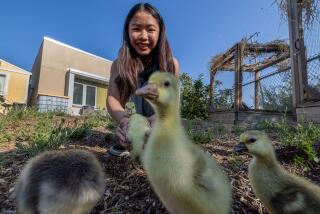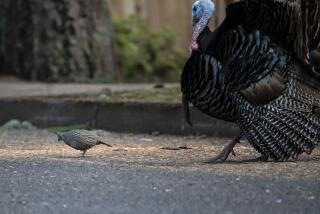Flight Patterns
The classroom at El Sereno Middle School was filled with the usual relics of past life-science projects: a row of molded brains, their folds painted purple and red, some papier-mache skulls dangling from the ceiling and a rusted copper boiler leaning in a corner.
By comparison, this day’s assignment might have seemed tame. Instructor Richard Birmele’s seventh-graders were using knives to cut holes in 2-quart soda bottles.
The exercise had some immediate educational aims, such as teaching how to recycle and converting millimeters into inches on small plastic rulers.
But the real payoff is months away, when migratory birds begin to visit the northeast Los Angeles area next fall. Then, if Birmele’s students have learned their lessons well, they will become participants in a nationwide research project conducted by Cornell University in Ithaca, N.Y.
The students were making bird feeders. They will hang them around campus and record the species that come to nibble. Their observations will be fed into a computer at Cornell’s Laboratory of Ornithology.
Scientists at the lab will blend the information with that provided by thousands of other schoolchildren around the country to help answer questions about birds, such as how populations change over time.
The Cornell lab is one of the foremost centers of bird study in the world, said Sally Conyne, director of citizen science for the National Audubon Society.
It gets its data from a network of bird-watchers in the United States and Canada who participate in the Audubon Society’s Project FeederWatch. The volunteers constitute a critical link in the scientific inquiry.
Their observations, for example, helped the lab in 1994 plot a temporary expansion of the wintering range of the common redpoll. Ornithologists had not previously been able to track that phenomenon, called irruption, with as much accuracy because of the difficulty of sampling the entire range of a species over a long period.
Teachers and students have contributed about 10% of the Project FeederWatch observations since the program began in 1987. Last year, Cornell, the Audubon Society and the National Science Foundation developed a comprehensive curriculum to augment the bird-watching.
About 500 schools now use it, Conyne said.
*
The curriculum employs the study of birds to teach students the scientific method. They learn to pose questions based on their observations. Some of the answers will be available in resource materials. But some questions--such as “What is the most common feeder bird at our school?”--the students must answer through their own investigations.
Other disciplines, such as art and electronic research, come into play as the students learn to sketch birds and communicate with the Cornell lab on the Internet.
“They can generate their own queries and pull data from the database and compare their observations with other kids and adults around the country,” Conyne said.
In urban schools, there is an added challenge because of the harsh environment for birds, said Melanie Ingalls, director of the Los Angeles chapter of the Audubon Society.
At El Sereno, Birmele is meeting that challenge by incorporating the feeder watch into a hands-on project on native ecology. The campus has a small wooded area that should be a magnet for native birds, but isn’t because of man-made changes.
First, a long-ago Department of Water and Power project dried up a small natural stream. More recently, the hillside was planted with lodgepole pine, an alpine tree that does not attract native birds, and the brush on the slope was replaced by invasive black mustard.
Birmele and two other science teachers have been restoring native toyon and enlisting students to pull out the interlopers.
“How many people here know what black mustard is?” he asked his students before a recent foray up the hill.
He then explained that black mustard is the name of the plant with bright yellow seed and that it spreads a substance in the ground that prevents native plants from growing.
“I want you to pull any black mustard you see,” he said.
The next step in the restoration will be obtaining water. Birmele said he is seeking the help of Quail Unlimited to pay for an ingenious self-charging watering system that collects dew in an underground cistern.
Someday, he hopes, students will participate in Project FeederWatch without the need for store-bought feed.
“It’s a beautiful curriculum, but it will be five years before we’re fully online,” Birmele said.







